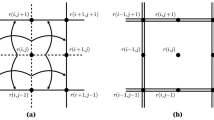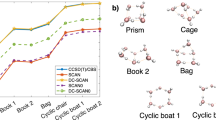Abstract
Quantum simulation methods based on electronic-structure theory are deemed unfit to cope with atomic heat transport within the Green–Kubo formalism, because quantum-mechanical energy densities and currents are inherently ill-defined at the atomic scale. We show that, although this difficulty would also affect classical simulations, thermal conductivity is indeed insensitive to such ill-definedness by virtue of a kind of gauge invariance resulting from energy extensivity and conservation. On the basis of these findings, we derive an expression for the adiabatic energy flux from density-functional theory, which allows heat transport to be simulated using ab initio equilibrium molecular dynamics. Our methodology is demonstrated by comparing its predictions to those of classical equilibrium and ab initio non-equilibrium (Müller–Plathe) simulations for a liquid-argon model, and by applying it to heavy water at ambient conditions.
This is a preview of subscription content, access via your institution
Access options
Subscribe to this journal
Receive 12 print issues and online access
$209.00 per year
only $17.42 per issue
Buy this article
- Purchase on Springer Link
- Instant access to full article PDF
Prices may be subject to local taxes which are calculated during checkout



Similar content being viewed by others
References
Klemens, P. G. Thermal conductivity and lattice vibrational modes. Solid State Phys. 7, 1–98 (1958).
Green, M. S. Markoff random processes and the statistical mechanics of time-dependent phenomena, II. Irreversible processes in fluids. J. Chem. Phys. 22, 398–413 (1954).
Kubo, R. Statistical-mechanical theory of irreversible processes. I. General theory and simple applications to magnetic and conduction problems. J. Phys. Soc. Jpn 12, 570–586 (1957).
Evans, D. J. & Morriss, G. Statistical Mechanics of Nonequilibrium Liquids 2nd edn (Cambridge Univ. Press, 2008).
Allen, M. P. & Tildesley, D. J. Computer Simulation of Liquids (Clarendon Press, 1987).
Müller-Plathe, F. A simple nonequilibrium molecular dynamics method for calculating the thermal conductivity. J. Chem. Phys. 106, 6082–6085 (1997).
Car, R. & Parrinello, M. Unified approach for molecular dynamics and density functional theory. Phys. Rev. Lett. 55, 2471–2474 (1985).
Marx, D. & Hutter, J. Ab initio Molecular Dynamics (Cambridge Univ. Press, 2012).
Stackhouse, S., Stixrude, L. & Karki, B. B. Thermal conductivitity of periclase (MgO) from first principles. Phys. Rev. Lett. 104, 208501 (2010).
Hohenberg, P. & Kohn, W. Inhomogeneous electron gas. Phys. Rev. 136, B864–B871 (1964).
Kohn, W. & Sham, L. Self-consistent equations including exchange and correlation effects. Phys. Rev. 140, A1133–A1138 (1965).
Kadanoff, L. P. & Martin, P. C. Hydrodynamic equations and correlation functions. Ann. Phys. 24, 419–469 (1963).
Forster, D. Hydrodynamic Fluctuations, Broken Symmetry, and Correlation Functions (Benjamin, 1975).
Helfand, E. Transport coefficients from dissipation in a canonical ensemble. Phys. Rev. 119, 1–9 (1960).
Resta, R. & Vanderbilt, D. Theory of polarization: A modern approach. Top. Appl. Phys. 105, 31–68 (2007).
Chetty, N. & Martin, R. M. First-principles energy density and its applications to selected polar surfaces. Phys. Rev. B 45, 6074–6088 (1992).
Ramprasad, R. First-principles energy and stress fields in defected materials. J. Phys. Condens. Matter 14, 5497–5516 (2002).
Perdew, J. P., Burke, K. & Ernzerhof, M. Generalized gradient approximation made simple. Phys. Rev. Lett. 77, 3865–3868 (1996).
Thouless, D. J. Quantization of particle transport. Phys. Rev. B 27, 6083–6087 (1983).
Resta, R. Manifestations of Berry’s phase in molecules and in condensed matter. J. Phys. Condens. Matter 12, R107–R143 (2000).
Baroni, S., de Gironcoli, S., Dal Corso, A. & Giannozzi, P. Phonons and related crystal properties from density-functional perturbation theory. Rev. Mod. Phys. 73, 515–562 (2001).
Giannozzi, P. et al. QUANTUM ESPRESSO: A modular and open-source software project for quantum simulations of materials. J. Phys. Condens. Matter 21, 395502 (2009).
Plimpton, S. Fast parallel algorithms for short-range molecular dynamics. J. Comput. Phys. 117, 1–19 (1995).
Grossman, J. C., Schwegler, E., Draeger, E. W., Gygi, F. & Galli, G. Towards an assessment of the accuracy of density functional theory for first principles simulations of water. J. Chem. Phys. 120, 300–311 (2004).
Silvestrelli, P., Bernasconi, M. & Parrinello, M. Ab initio infrared spectrum of liquid water. Chem. Phys. Lett. 277, 478–482 (1997).
Marcolongo, A. Theory and Ab initio Simulation of Atomic Heat Transport PhD thesis, SISSA (2014); http://cm.sissa.it/thesis/2014/marcolongo
Matsunaga, N. & Nagashima, A. Transport properties of liquid and gaseous D2O over a wide range of temperature and pressure. J. Phys. Chem. Ref. Data 12, 933–966 (1983).
Ramires, M. L. V. et al. Standard reference data for thermal conductivity of water. J. Phys. Chem. Ref. Data 24, 1377–1381 (1994).
Acknowledgements
S.B. gratefully acknowledges useful discussions with T. Sun and D. Alfè in the early phases of this work and, more recently, with R. Car and R. Resta. All of the authors gratefully thank L. Colombo, C. Melis, S. R. Philpot and A. Chernatynskiy for communicating to them some of their unpublished material.
Author information
Authors and Affiliations
Contributions
All authors contributed to all aspects of this work.
Corresponding author
Ethics declarations
Competing interests
The authors declare no competing financial interests.
Rights and permissions
About this article
Cite this article
Marcolongo, A., Umari, P. & Baroni, S. Microscopic theory and quantum simulation of atomic heat transport. Nature Phys 12, 80–84 (2016). https://doi.org/10.1038/nphys3509
Received:
Accepted:
Published:
Issue Date:
DOI: https://doi.org/10.1038/nphys3509
This article is cited by
-
Programmable repulsive potential for tight-binding from Chen-Möbius inversion theorem
Science China Physics, Mechanics & Astronomy (2024)
-
Hydrodynamic finite-size scaling of the thermal conductivity in glasses
npj Computational Materials (2023)
-
Thermal conductivity of glasses: first-principles theory and applications
npj Computational Materials (2023)
-
Temperature- and vacancy-concentration-dependence of heat transport in Li3ClO from multi-method numerical simulations
npj Computational Materials (2022)
-
Thermal transport and phase transitions of zirconia by on-the-fly machine-learned interatomic potentials
npj Computational Materials (2021)



